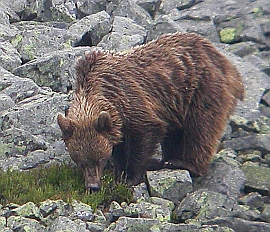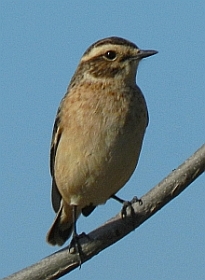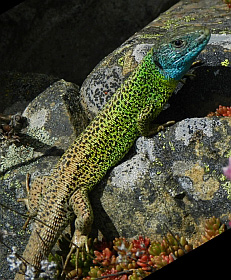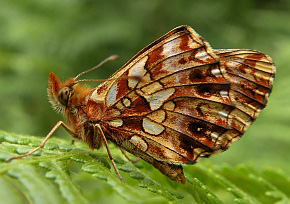 |
 Cantabrican Brown Bear Ursus arctos
© Fundación Oso Pardo
Cantabrican Brown Bear Ursus arctos
© Fundación Oso Pardo
In Search of the Littlest Grizzly: Cantabrican Brown Bears in the Somiedo Natural Park
A week spent observing these endangered mammals amid the superb mountain scenery of western Asturias, plus an abundance of other late-summer wildlife
Lying towards the western end of the Cordillera Cantábrica, the Somiedo parque natural is a remarkable enclave of deciduous and evergreen forest, herb-rich pastures and haymeadows. Straddling precipitous river gorges, and liberally studded with jagged limestone outcrops, Somiedo houses one of the principal nuclei of Brown Bears in Spain. Over the past decade, concerted efforts by the Fundación Oso Pardo (Brown Bear Foundation) – in conjunction with statutory conservation bodies and the local farmers – have resulted in a substantial increase in the number of bears using the park, with recent estimates standing at 35 to 40 individuals.
 Cantabrican Brown Bear foraging for bilberries© Fundación Oso Pardo Cantabrican Brown Bear foraging for bilberries© Fundación Oso Pardo
This tour will be run in collaboration with the Fundación Oso Pardo (FOP), whose wardens closely monitor the movements of the various bears within the Somiedo park, as well as in the nearby Villablino enclave, on the southern flanks of the Cordillera Cantábrica. Throughout the week, one or more FOP wardens will accompany our party on all the morning and evening watches, as well as giving us advice as to the best spots to observe other wildlife in and around Somiedo. This arrangement will not only give us the best possible chance of viewing bears in the wild, but will also allow us to learn more about the biology and behaviour of these magnificent plantigrades from the recognised experts.
Our visit is timed for late summer as this is undoubtedly the best period in which to observe Brown Bears in northern Spain. At this time of year, wandering immature bears and mothers with cubs emerge from the thick forests to gorge themselves on the fruits of berry-bearing trees and shrubs, particularly Alpine Buckthorn. This shrub – abundant in Somiedo – usually grows in quite open locations and so is an ideal autumn food resource for mother bears as they can also keep a keen eye out for itinerant males, who can be a significant threat to their cubs, since they will attempt to kill them in order to bring the females back into breeding condition.
 Whinchat Saxicola rubetra© Teresa Farino Whinchat Saxicola rubetra© Teresa Farino
However, in such beautiful surroundings it would be criminal just to concentrate on the bears and ignore everything else, so in between intensive bouts of bear-watching, particularly at dawn and dusk (when they are most active), we will be exploring different habitats in and around Somiedo in search of some of the park's other notable flora and fauna.
Of the other wild mammals that inhabit Somiedo, we might also encounter Wildcats, Common Genets, Wild Boar, Southern Chamois and possibly even Wolves. Almost all the western European forest mustelids maintain good populations in the park, while the numerous mountain watercourses are home to Otters and Pyrenean Desmans. Castroviejo's Hare – endemic to upland scrub habitats in the Cordillera Cantábrica – and Snow Vole are the most noteworthy montane mammals of Somiedo.
Although the peak period of breeding bird activity is well over by the end of August, we will also be looking at the variety of resident and migrant birds present in the park. Apart from the ubiquitous Griffon Vultures, other raptors we might encounter include Red Kite, Booted and Short-toed Eagles, Goshawk, Hobby and Peregrine Falcon. Among the smaller birds, we should be able to locate Crag Martin, Short-toed Treecreeper, Whinchat, Firecrest, Iberian Chiffchaff, Serin and Rock and Cirl Buntings.  Male Schreiber's Green Lizard Male Schreiber's Green Lizard
Lacerta schreiberi© Teresa Farino In the high mountains we must keep an eye out for Water Pipit, and Red-billed and Alpine Choughs, and we might also be lucky to spot Rufous-tailed Rock Thrush, Alpine Accentor, Wallcreeper or Snowfinch. Somiedo's cascading streams and rivers hold good numbers of Grey Wagtails and White-throated Dippers, and while Black Woodpeckers breed in the most remote forests, post-nuptial dispersion means that come late summer these magnificent birds might be seen in almost any wooded habitat.
Reptiles and amphibians of particular interest in the park include a number of species whose world distribution is limited to western Iberia: Golden-striped Salamander, Bosca's Newt, Iberian Frog, Schreiber's Green, Bocage's and León Rock Lizards and Seoane's Viper. Equally beguiling are more widespread reptiles such as Ocellated and Viviparous Lizards and Southern Smooth Snake, with other amphibians we should be keeping an eye out for including Fire Salamander, Alpine Newt and Midwife Toad.
Given decent weather, good numbers of butterflies should still be on the wing, including both Swallowtail and Scarce Swallowtail, Cleopatra, Berger's Clouded Yellow, Wood White, Oberthür's Grizzled, Silver-spotted, Red-underwing and Mallow Skippers, Scarce and Sooty Coppers, Turquoise, Adonis, Chalk-hill and Lang's Short-tailed Blues, Spanish Argus, Queen of Spain, High Brown and Weaver's Fritillaries, Rock and Tree Graylings, Black Satyrs, several species of ringlets and – at altitude – possibly even the last Apollos of the season.
 Weaver's Fritillary Boloria dia© Teresa Farino Weaver's Fritillary Boloria dia© Teresa Farino
Somiedo's glacial lakes – scenically one of the highlights of the park – and peat-bogs might also reward us with a few emblematic dragonflies, including Common Goldenring, Moorland Hawker (scarce in Spain) and Yellow-winged Darter, with Western Spectre possible in the lower river valleys. Late summer is also the best season for spotting some of the amazing grasshoppers and crickets of northern Spain, when the air is alive with the many and varied calls of males trying to attract a mate. Among the most characteristic species here are Asturian, Lusitanian and Great Green Bush-crickets and Wart-biters.
Although the haymeadows will have been cut by the time of our visit, the waysides are still coloured by flowers such as Fringed Pink, Moon Carrot, Bloody Crane's-bill and Cornish Heath, while some of the autumn specialities will also be coming into bloom: Monk's-hood, Grass-of-Parnassus, Merendera, Meadow Saffron, Autumn Crocus and Autumn Lady's-tresses, for example. Assuming the summer has not been too dry, there is also the chance that we might encounter the delightful pink flowers of the Somiedo endemic centaury Centaurium somedanum.
As part of our commitment to bear conservation in Spain, we shall be purchasing a year's membership subscription to the Fundación Oso Pardo for all tour participants, providing they agree to this on the booking form.
"That was one of the best holidays ever - I just cannot get over how lovely seeing the bears was - I never thought we would see them so often and so many. It was such a wonderful area - and so Brits-free which is bad for the Bear Foundation but great for us; hotel fine - food ditto." Virginia B. October 2013
 Autumn Lady's-tresses Spiranthes spiralis
© Teresa Farino
Autumn Lady's-tresses Spiranthes spiralis
© Teresa Farino
In Search of the Littlest Grizzly: Cantabrican Brown Bears in Somiedo
Leaders: Teresa Farino, John Muddeman and wardens of the FOP
2014 Dates: Sun. 24 August – Sun. 31 August
Price: 1,290€, including half-board, en suite accommodation at the comfortable, family-run Casa Mińo, picnic lunches, hired minibus transport throughout, all entry fees and the services of the leader. A single-room supplement of 135€ is applicable. Although the cost of the tour is given in euros, clients may pay in sterling, the exchange rate to be calculated at the time of payment using www.oanda.com.
This is a land-based tour. Flights and travel insurance (obligatory) are the responsibility of the client.
Pick-up details: On 24 August, Teresa will be meeting easyJet flight 3083, which departs London Stansted at 11.30 and arrives in Asturias at 14.25. On 31 August, we shall be travelling back to Asturias airport in plenty of time to catch easyJet flight 3084, which departs at 15.00 and arrives back in Stansted at 15.50.
Alternatively, those travelling to Somiedo independently can arrange to meet the group at Casa Mińo on the first evening.
Group size: maximum 8 persons.
Booking information: please contact Teresa Farino for further details and a booking form, or if you have any queries about this tour.
| E-mail: |
|
|
| Office phone: | (+34) 942 735154 |
| Mobile phone: | (+34) 656 337129 |
|
| Address: |
Apartado de Correos 59
39570 Potes
Cantabria
Spain
|
|